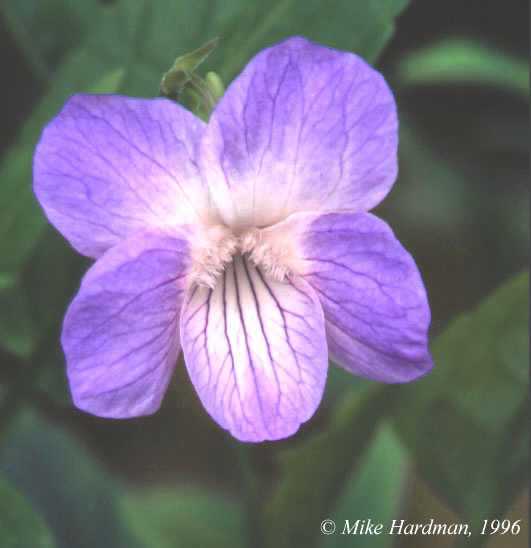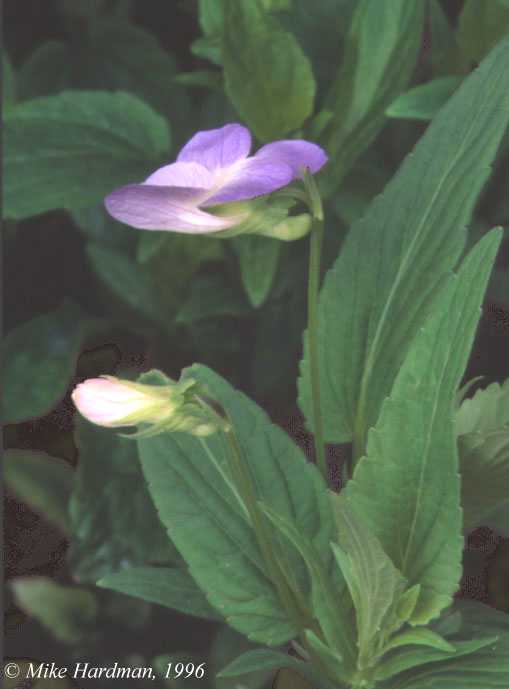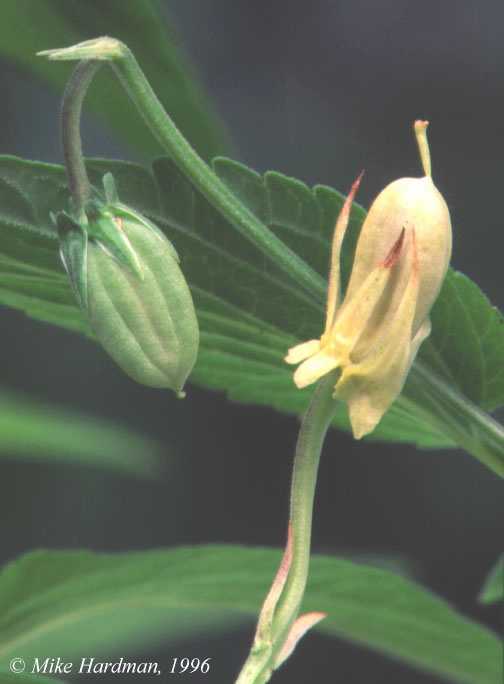
Text and photographs © Mike Hardman,
1997
Aptly named elatior, meaning 'taller',
by Fries in 1828, this good garden plant has been called Viola erecta
and, misleadingly, tree violet, but has never had a really interesting
English name. That's not surprising, perhaps, since it doesn't come from
English-speaking lands, but even where native, such as the Czech Republic
and Estonia, its common name often still translates to 'taller'. In Sweden
its name 'storviolen' can at least be translated as 'great violet'. A better
name, and I am sure it would be more widely grown; it deserves to be. Any
suggestions ?

Pale blue to mauve flowers veined with white, each 1 inch or so across, emerge from creamy buds in May and June in the northern hemisphere. There is no scent, unfortunately, but they have a wonderful lightness and freshness of face. The elongate leaves have a certain smartness, which naturally complements the elegant upright habit of the plant. At its peak it may reach 8-24 inches tall, depending on its growing conditions. Shelter, careful staking, and growing amongst supporting herbaceous perennials will all help the violet retain its elegance. However, eventually it dies down to ground level for winter, so needs to be marked to avoid digging it up by mistake. If you're the sort of person who doesn't mind leaving hydrangea flower heads unsevered over winter to protect against frost, you probably won't mind using the untidy old brown violet stems to do the marking for you.
A hardy perennial, this species is native
to marshy grassland, wet woods and waterside rocks from central Europe
to western Asia, including the harsh climates of Siberia and Xinjiang province
in western China. A southern outpost in Europe may have been discovered
in northern Italy by children working on a school project in their local
valley - but I am still working with them to confirm this - so don't quote
me yet!

In the wild it prefers a moist soil and will tolerate either sun or shade. In a garden it will actually survive in many situations, even dry chalky soil. But to thrive, I recommend growing it in a fairly sunny spot in moist but not clayey soil. I would be interested to hear others' opinions about its likes and dislikes when in cultivation.
Viola elatior suffers the same pests as most violets, though if grown in the moist soils it prefers, red spider mite is less likely to occur. And, perhaps because it has evolved to cope with moist soils and inundation, it seems to fend off rots and other fungal diseases a little better than most. A few years ago a tortrix moth laid her eggs on a leaf of one of my taller violets. The eggs were protected in a marvelous pearly shield of imbricate translucent cells, the like of which I had never seen before. When the larvae hatched, they mostly dispersed from the plant to go and feed elsewhere, though some became breakfast for a tiny resident spider. A fascinating drama in miniature!
The allied species V.persicifolia Schreber, the fen violet, which used to be called V.stagnina Kitaibel, has been much studied in England in recent years in order to try to understand why it has become so scarce there and how it can be encouraged to rebuild its numbers. This work included a visit to the Czech Republic, where the fen violet and taller violet both occur.
One of the problems with the fen violet seems to be its need for some disturbance of the site, possibly to reduce competition from perennial plants during the violet's initial growth.
This factor could also apply to the taller violet, which, in Switzerland, is also struggling in the wild. In fact, it may be the rarest wild flower in Switzerland - it had not been officially recorded at all between 1977 and 1994. But Dr Ernst Müller rediscovered it, and in 1995 an integrated conservation programme was begun by the Botanic Garden, Botanic Institute, and local government in Bern. The aim was to try to perpetuate it at the existing site and to reintroduce it to former sites. Much of the reason for its decline was loss of habitat through adverse land management practices, for instance allowing sites to dry out, become choked with reeds, or used for dumping waste. Since, through experiment and historical research, suitable moisture levels and grazing regimes have been identified and remedial work begun, the species should stand a good chance of recovery, aided by the good seed harvests from existing plants. In other parts of its range, such as in Sweden and Baden-Würtemburg in Germany, the taller violet is also under study by conservationists. I have talked with several researchers in this field, and it is clear that, although practical progress is being made, we still have a lot to learn; we know how much better than we know why.
I should balance this discussion by pointing
out that in Switzerland and Sweden, as discussed above, V.elatior
is at the edge of its range - so environmental pressures are always more
likely to endanger it. However, across the majority of Asia, this violet
is probably more secure.

Seed is usually produced in ample quantity. It stores well and germinates without difficulty, especially if kept moist and cold over winter. Taller violet is grown by many botanic gardens around the world, such as the Mount Lofty Botanic Garden in Australia and the RHS garden at Wisley in England. This means it ought to be relatively easily obtainable through seed exchange schemes. In fact, the plants I grow at home arose from the annual seed distribution to members of the RHS. V.elatior also crops up on the seed list of the North American Rock Garden Society.
Depending on how well they are looked after, plants may flower a year after sowing, though even in their first autumn they may set seed from their cleistogamous flowers. For quicker results, however, plants at least one or two years old may be bought. And bear in mind that, if grown well, the clumps will expand year by year, so a four year old plant could produce a bounty of blooms. Once you have flowering plants you should get all the seed you need. But watch those seed pods - they may take weeks develop, but once they have turned upright you have only a few days before they split and shed their seeds. Cut each seed pod off well down its flower stalk a day or two after it turns upright, then keep it in a paper bag until the seeds are shed. This technique works for most violets except those which develop their seedpods at ground level.
Many nurseries stock Viola elatior. In North America or Europe, consult The Plant Finder, PPP Index or Andersen List. In Australia, try: W.A. & I.A. Coffield's Nursery, Lot 4, Daylesford Road, Creswick 3363, Victoria, Australia (tel. 053-452268).